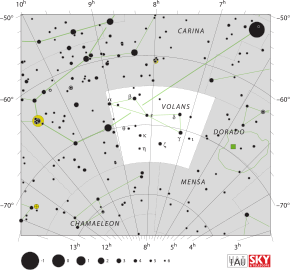
Back Vlieënde Vis Afrikaans السمكة الطائرة (كوكبة) Arabic ڤولانس ARZ Volans AST Uçan Balıq (bürc) Azerbaijani Елбәҙәк Балыҡ (йондоҙлоҡ) Bashkir Лятучая Рыба (сузор’е) Byelorussian Лятучая Рыба (сузор’е) BE-X-OLD Летяща риба (съзвездие) Bulgarian Pesk-nij (steredeg) Breton
| Constellation | |
 | |
| Abbreviation | Vol |
|---|---|
| Genitive | Volantis |
| Pronunciation | /ˈvoʊlænz/, genitive /vɒˈlæntɪs/ |
| Symbolism | the Flying Fish |
| Right ascension | 06h 31m 04.9703s–09h 04m 22.7345s[1] |
| Declination | −64.1070251°–−75.4954681°[1] |
| Quadrant | SQ2 |
| Area | 141 sq. deg. (76th) |
| Main stars | 6 |
| Bayer/Flamsteed stars | 12 |
| Stars with planets | 2 |
| Stars brighter than 3.00m | 0 |
| Stars within 10.00 pc (32.62 ly) | 1 |
| Brightest star | γ2 Vol (3.62m) |
| Messier objects | 0 |
| Meteor showers | 0 |
| Bordering constellations | Carina Pictor Dorado Mensa Chamaeleon |
| Visible at latitudes between +15° and −90°. Best visible at 21:00 (9 p.m.) during the month of February. | |
Volans is a constellation in the southern sky. It represents a flying fish; its name is a shortened form of its original name, Piscis Volans.[2] Volans was one of twelve constellations created by Petrus Plancius from the observations of Pieter Dirkszoon Keyser and Frederick de Houtman and it first appeared on a 35-cm (14") diameter celestial globe published in 1597 (or 1598) in Amsterdam by Plancius with Jodocus Hondius. The first depiction of this constellation in a celestial atlas was in Johann Bayer's Uranometria of 1603.[2]
- ^ a b IAU, The Constellations, Volans.
- ^ a b Staal 1988, p. 244.